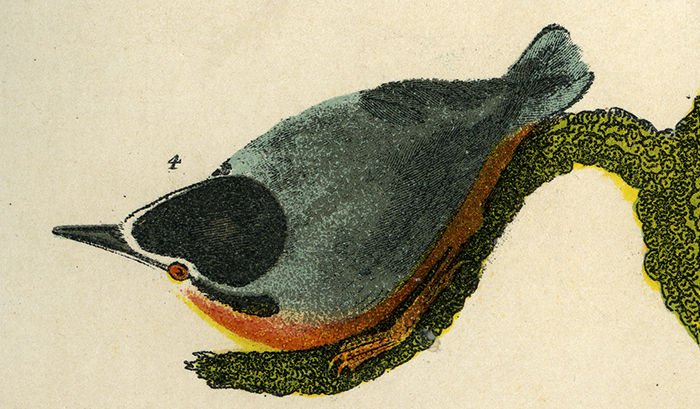
Sitta varia, Bart. p. 289.
Sitta Canadensis, Turton.
Small Nuthatch, Lath. i. 651.
SITTA CANADENSIS.—LINNÆUS.
Sitta Canadensis, Bonap. Synop. p. 96.
This bird is much smaller than the last, measuring only four inches and a half in length, and eight inches in extent. In the form of its bill, tongue, nostrils, and in the colour of the back and tail-feathers, it exactly agrees with the former; the secondaries are not relieved with the deep black of the other species; and the legs, feet, and claws are of a dusky greenish-yellow; the upper part of the head is black, bounded by a stripe of white passing round the frontlet; a line of black passes through the eye to the shoulder; below this is another line of white; the chin is white; the other under parts a light rust colour, the primaries and whole wings a dusky lead colour. The breast and belly of the female are not of so deep a brown, and the top of the head is less intensely black.
This species is migratory, passing frotn the north, where they breed, to the southern States, in October, and returning in April. Its voice is sharper, and its motions much quicker, than those of the other, being so rapid, restless, and small, as to make it a difficult point to shoot one of them. When the two species are in the woods together, they are easily distinguished by their voices, the note of the least being nearly an octave sharper than that of its companion, and repeated more hurriedly. In other respects, their notes are alike unmusical and monotonous. Approaching so near to each other in their colours and general habits, it is probable that their mode of building, &c, may be also similar.
Buffon’s Torchepot de la Canada (Canada nuthatch of other European writers) is either a young bird of the present species, in its imperfect plumage, or a different sort, that rarely visits the United States. If the figure (Pl. enl. 623) be correctly coloured, it must be the latter, as the tail and head appear of the same bluish grey or lead colour as the back. The young birds of this species, it may be observed, have also the crown of a lead colour during the first season; but the tail-feathers are marked nearly as those of the old ones. Want of precision in the figures and descriptions of these authors makes it difficult to determine; but I think it very probable that Sitta Jamaicensis minor, Briss., the least loggerhead of Brown, Sitta Jamaicensis var. t. st., Linn., and Sitta Canadensis of Linnæus, Gmelin, and Brisson, are names that have been originally applied to different individuals of the species we are now describing.
This bird is particularly fond of the seeds of pine trees. You may traverse many thousand acres of oak, hickory, and chestnut woods, during winter, without meeting with a single individual; but no sooner do you enter among the pines than, if the air be still, you have only to listen for a few moments, and their note will direct you where to find them. They usually feed in pairs, climbing about in all directions, generally accompanied by the former species, as well as by the titmouse, Parus atricapillus, and the crested titmouse, Parus bicolor, and not unfrequently by the small spotted woodpecker, Picus pubescens; the whole company proceeding regularly from. tree to tree through the woods like a corps of pioneers; while, in a calm day, the rattling of their bills, and the rapid motions of their bodies, thrown, like so many tumblers and rope dancers, into numberless positions, together with the peculiar chatter of each, are altogether very amusing; conveying the idea of hungry diligence, bustle, and activity.[15] Both these little birds, from the great quantity of destructive insects and larvæ they destroy, both under the bark and among the tender buds of our fruit and forest trees, are entitled to, and truly deserving of, our esteem and protection.
[15] It is curious to remark the similarity, as it were in the feeling and disposition of some species. In this country during winter when the different kinds have laid aside those ties which connected them by sexual intercourse, nothing is more common than to see a whole troop of the blue, marsh, cole, and long-tailed titmice, accompanied with a host of golden-crested wrens, and perhaps a solitary creeper; proceed in the manner here mentioned, and regularly follow each other, as if in a laid-out patch. An alarm may cause a temporary digression of some of the troop; but these are soon perceived making up their way to the main body. The whole may be found out and traced by their various and constantly reiterated cries.—Ed. [return]

